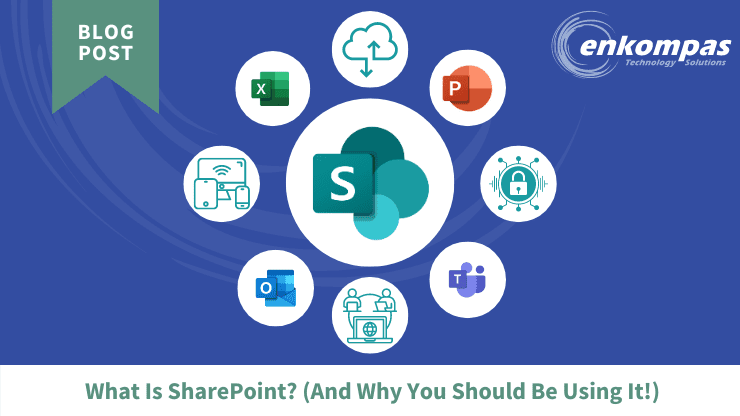What is SharePoint?
If you work in an office environment or have heard about Microsoft 365’s suite of productivity tools, chances are you’ve come across the term “SharePoint.” But what exactly is SharePoint, and what does it do?
At its core, SharePoint is a web-based collaborative platform that integrates with Microsoft Office. It serves as a central hub for teams to share and manage digital information, collaborate effectively, and streamline and automate workflows. SharePoint is designed to enhance productivity, facilitate communication, and provide a secure environment for storing and accessing data. As part of your Microsoft 365 environment, SharePoint is also a cloud-based platform, which allows businesses to easily scale up or down according to their business needs, as well as to potentially eliminate expensive servers.
Key Components and Features of SharePoint
SharePoint is a very powerful tool, but these six elements represent the most commonly used and beneficial features of the platform.
1. Centralized Document Management
This is one of SharePoint’s primary functions. SharePoint allows teams to store, share, and collaborate on all types of Microsoft files – Word documents, Excel spreadsheets, PowerPoint presentations, and more. SharePoint ensures version control, allowing multiple users to work on the same document simultaneously while tracking changes and preventing conflicts. And there’s no more confusion about what version you’re on – everyone has access to the latest version.
What’s more, SharePoint helps teams collectively manage the entire life cycle of files, from creating, reviewing, editing, approving, and publication, plus either retention or disposal once files become outdated.
Plus, you can create separate SharePoint sites for specific groups, which further helps in several ways. But we’ll come back to team sites in a moment.
2. Integration with Microsoft Office – and More
As you may have guessed from the above, SharePoint seamlessly integrates with Microsoft Office applications like Word, Excel, PowerPoint, and Outlook. This integration allows you to access and work on SharePoint content directly from within these familiar Microsoft Office tools, providing a consistent and efficient user experience. For each component of Microsoft Office, users have the option to work within the applications or within a web browser.
In addition to integrating with Microsoft Office, SharePoint integrates with applications beyond the Microsoft ecosystem. These integrations include platforms commonly used by HR, sales, and IT teams, including SalesForce, Workday, and ZenDesk. These integrations allow users to perform certain functions within their core work environment without having to visit the specific platform in question. SharePoint workflows can also be leveraged via these integrations. For example, a form on SharePoint could be used to send information about a client into SalesForce. Find more on workflows below.
3. Team Sites
SharePoint allows teams to create dedicated sites where they can share information, access team calendars, manage tasks, collaborate on projects, and so on. These team sites serve as virtual workspaces, fostering communication and collaboration among team members. As we alluded to above, team sites contribute positively toward document management. Creating team sites for departments or other work groups allows them to determine how to organize and manage their files.
Plus, this represents one level of the robust permissions and access controls SharePoint offers your business. Only members of a specific team site can access the files within the site, eliminating the chances for people outside the team opening, changing, or deleting any of the team’s files.
4. Workflows and Automation
SharePoint allows you to automate and streamline business processes through customizable workflows. For example, you can create workflows for document approval processes, issue tracking, or task assignments, helping to increase efficiency by reducing the need to repeatedly complete administrative tasks manually.
In addition to boosting productivity by eliminating manual tasks, automated workflows can help your organization ensure steps in a critical process never get overlooked or skipped.
5. Search and Discoverability
Even with SharePoint’s ability to organize an organization’s files, we simply can’t always remember where every digital item might be stored. But that’s no problem in SharePoint! With SharePoint’s powerful search capabilities, you can quickly locate the information you need, whether it’s a document, a list item, or a website. Advanced search filters and metadata tagging make it easier to narrow your search and find relevant content within your organization’s vast digital resources.
6. Intranet and Extranet
SharePoint can be used to create intranets (internal websites) and extranets (external websites) for your organization. These sites can serve as centralized hubs for sharing news, resources, and information with employees, partners, or customers, fostering better communication and collaboration. That is, you can not only create sites for specific teams within your organization, but you can also create sites that allow you to collaborate with partners, clients, vendors, and contractors, as needed.
Additional Benefits of SharePoint
In addition to the features above – all the things SharePoint can do to enhance your work environment – SharePoint offers benefits to the overall health of your organization at the highest level. Consider how the benefits listed below are multiplying factors to an organized, automated, and collaborative SharePoint environment.
1. Mobile Access and Remote Collaboration
For our hybrid and fully remote workplaces, productivity isn’t confined to the desk. SharePoint offers mobile access, allowing team members to access and collaborate on content from virtually anywhere, using their smartphones or tablets. This flexibility ensures that work can continue seamlessly, even when team members work remotely, meeting clients, or otherwise on the go.
2. Enhanced Security and Data Protection
Cloud storage providers like SharePoint invest heavily in robust security measures, including advanced encryption, access controls, and regular backups. This level of protection likely exceeds what your businesses can achieve with on-premises storage solutions. Additionally, cloud storage mitigates the risk of data loss due to hardware failures, natural disasters, or other unforeseen events.
3. Scalability and Cost-Efficiency
On-premises storage solutions often require significant upfront investments in hardware, maintenance, and IT resources. With SharePoint’s cloud storage, you can easily scale your storage capacity up or down based on your organization’s changing needs, without the need for costly infrastructure upgrades. This pay-as-you-go model can result in significant cost savings, especially for growing businesses and businesses which are highly seasonal.
SharePoint Does All This and More
The lists above capture the primary features and benefits of SharePoint, but it’s worth noting that there are dozens and dozens of features available for customizing your SharePoint environment. For example, you can customize your SharePoint sites with your company’s branding – without needing to acquire any developer skills.
Enhanced Features
Also, there are elements you can build into sites like news alerts, event calendars, and RSS feeds. For example, if you have a form that needs to be completed repeatedly, you can grant employees access to it from a button on your corporate SharePoint. For example, if your sales team completes onboarding forms for each new client, they can get to a fillable form with a single click on SharePoint. Once they capture the details in the form, they information will be stored on SharePoint, as well.
SharePoint – A Highly Valuable Tool at Your Fingertips
At the end of the day, SharePoint is a scalable and flexible platform which can be tailored to support various business processes, workflows, and collaboration requirements. It’s a powerful collaboration and content management platform that enables teams to work more efficiently, share information seamlessly, and streamline processes.
And because it’s scalable, SharePoint can be a valuable tool for enhancing productivity and fostering a collaborative work environment whether you’re a large enterprise or a small business. If you’re working in a Microsoft 365 environment consider how you can leverage this powerful tool.
About enkompas Technology Solutions
enkompas powers your entire technology environment, working closely with your team to provide strategic enterprise technology solutions. With nearly 30 years of experience as a trusted Managed IT Services Provider, our goal is to help you build a secure, scalable organizational roadmap for your IT environment. Contact us for more information about how enkompas Technology Solutions partners with our clients to fully understand your business and provide Sharepoint solutions tailored to your needs – we support your environment, so you don’t have to.


